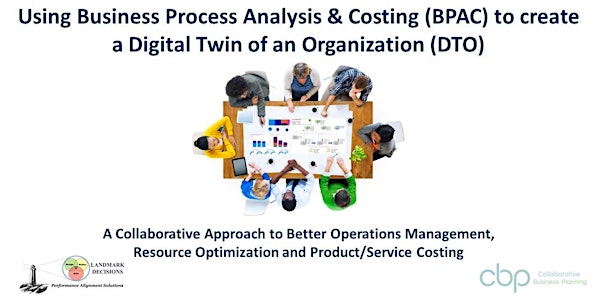
Using BPAC to create a Digital Twin of an Organization (DTO) - Cdn Reg.
NOTE: This is the Canadian registration and includes tax. If outside of Canada, please use the US$ (no tax) link at the bottom of this page.
Date and time
Location
Online
Refund Policy
About this event
- 3 days 3 hours
Gartner defines a Digital Twin of the Organization (DTO) as "a dynamic software model of any organization that relies on operational and contextual data to understand how an organization operationalizes its business model, connects with its current state, responds to changes, deploys resources, and delivers customer value."
Developed and delivered by Landmark Decisions, this virtual workshop helps organizations define the critical success factors associated with designing content to support a DTO. Using real-world examples and interactive case study exercises, participants come away with “ready to apply” tips and techniques to enhance process efficiency and improve operational/service/product costing and profitability initiatives in their own organizations.
NOTE: This virtual workshop is delivered over four consecutive half-day sessions
Key Learning Objectives
- Learn how to initiate, align, and sustain business process analysis (BPA) and improved operational costing in your organization
- Develop firsthand experience in building meaningful resource management and “Closed Loop” operational planning and costing models
- Appreciate the value of planning in a collaborative environment to improve the long-term sustainability of the enterprise
- Understand the role of technology using an illustrative DTO software, Collaborative Business Planning (CBP), for visualization, analysis and scenario playing purposes.
Who Should Attend and Why?
This workshop provides foundational training on developing high quality business process/cost management content in any organization. It will benefit the following roles and suggested that participants may wish to attend as a team to realize the full potential of developing and using DTO’s in a collaborative setting.
- Strategic managers tasked with charting the impact of organizational change
- Operational managers needing to manage resource capacity requirements for doing more with less while identifying opportunities for business process improvement
- Financial and resource management personnel responsible for resource planning, operational budgeting and/or costing and profitability analysis
Course Outline
Key Opportunities for Improved Business Processes
- Common challenges in business process analysis and operational costing
- The value proposition for enhancing resource and cost management practices
- Aligning business process analysis with performance indicators and targets
Fundamentals of Business Process Analysis & Costing (BPAC)
- Understanding resource capacity and utilization
- Linking process improvement techniques like LEAN and Activity-Based Planning
- Scenario-playing for improved organizational efficiency
The Eight Steps to Designing a DTO
- Conduct a strategic assessment to determine operational improvement objectives
- Analyze current business resources and linkages to organization outputs
- Perform a process analysis to understand business flows and enhancement opportunities
- Design the DTO model diagram to define data collection requirements
- Collect relevant operational and financial data to populate the DTO model
- Build and validate the DTO model using representative DTO software
- Enhance process and cost understanding and identify business improvement opportunities
- Optimize and plan for the future using “what-if” DTO scenario-playing capabilities
The Role and Value of DTO Technology
- How technology enhances organizational engagement
- The value proposition for implementing DTO technology
- Applying BPAC concepts using a representative DTO software
Initiating, Aligning and Sustaining DTO Models
- Identifying major hurdles to successfully implementing DTO models
- Considerations and benefits of deploying a DTO pilot
- Use case examples of organizations which implemented/benefited from a DTO
Workshop Dates/Times:
Monday, June 3 - Thursday, June 6, 2024 : 8:30am - Noon Eastern each day
Instructor
Mike Haley, M.Sc., is President of Landmark Decisions Inc., a Canadian niche consulting firm providing worldwide “performance alignment” facilitation, training, and implementation services. Mike has over 25 years’ experience in developing and delivering professional training on strategic and operational planning and cost modeling techniques which help both private and public-sector organizations improve their business decision-making capacity.
Mike has worked with private-sector clients such as Air Canada, Bell Aliant, Crosby's Molasses, Kroger Foods, Maersk-Sealand, Pfizer, and Telekom Malaysia. Public sector clients have included Canada Council for the Arts, Health Canada, Nova Scotia Crown Lending Agency, Treasury Board Secretariat, Veterans Affairs, US Navy, and various departments in the New Zealand government.
PLEASE NOTE: If you are registering as a Non-Canadian participant, please use the Non-Canadian registration page (No Tax - US$) here.